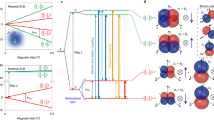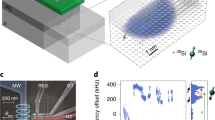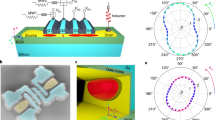Abstract
Spins in semiconductor quantum dots constitute a promising platform for scalable quantum information processing. Coupling them strongly to the photonic modes of superconducting microwave resonators would enable fast non-demolition readout and long-range, on-chip connectivity, well beyond nearest-neighbour quantum interactions. Here we demonstrate strong coupling between a microwave photon in a superconducting resonator and a hole spin in a silicon-based double quantum dot issued from a foundry-compatible metal–oxide–semiconductor fabrication process. By leveraging the strong spin–orbit interaction intrinsically present in the valence band of silicon, we achieve a spin–photon coupling rate as high as 330 MHz, largely exceeding the combined spin–photon decoherence rate. This result, together with the recently demonstrated long coherence of hole spins in silicon, opens a new realistic pathway to the development of circuit quantum electrodynamics with spins in semiconductor quantum dots.
This is a preview of subscription content, access via your institution
Access options
Access Nature and 54 other Nature Portfolio journals
Get Nature+, our best-value online-access subscription
$29.99 / 30 days
cancel any time
Subscribe to this journal
Receive 12 print issues and online access
$259.00 per year
only $21.58 per issue
Buy this article
- Purchase on Springer Link
- Instant access to full article PDF
Prices may be subject to local taxes which are calculated during checkout




Similar content being viewed by others
Data availability
The datasets generated during the current study are available via Zenodo at https://doi.org/10.5281/zenodo.7533669.
Code availability
The code used to analyse the datasets are available via Zenodo at https://doi.org/10.5281/zenodo.7533669.
References
Haroche, S. and Raimond, J.-M. Exploring the Quantum: Atoms, Cavities, and Photons (Oxford Univ. Press, 2006).
Wallraff, A. et al. Strong coupling of a single photon to a superconducting qubit using circuit quantum electrodynamics. Nature 431, 162–167 (2004).
Blais, A., Huang, R.-S., Wallraff, A., Girvin, S. M. & Schoelkopf, R. J. Cavity quantum electrodynamics for superconducting electrical circuits: an architecture for quantum computation. Phys. Rev. A 69, 062320 (2004).
Blais, A., Grimsmo, A. L., Girvin, S. & Wallraff, A. Circuit quantum electrodynamics. Rev. Mod. Phys. 93, 025005 (2021).
Clerk, A. A., Lehnert, K. W., Bertet, P., Petta, J. R. & Nakamura, Y. Hybrid quantum systems with circuit quantum electrodynamics. Nat. Phys. 16, 257–267 (2020).
Childress, L., Sørensen, A. S. & Lukin, M. D. Mesoscopic cavity quantum electrodynamics with quantum dots. Phys. Rev. A 69, 042302 (2004).
Burkard, G. & Imamoglu, A. Ultra-long-distance interaction between spin qubits. Phys. Rev. B 74, 041307(R) (2006).
Hu, X., xi Liu, Y. & Nori, F. Strong coupling of a spin qubit to a superconducting stripline cavity. Phys. Rev. B 86, 035314 (2012).
Jin, P. Q., Marthaler, M., Shnirman, A. & Schön, G. Strong coupling of spin qubits to a transmission line resonator. Phys. Rev. Lett. 108, 190506 (2012).
Frey, T. et al. Dipole coupling of a double quantum dot to a microwave resonator. Phys. Rev. Lett. 108, 046807 (2012).
Petersson, K. D. et al. Circuit quantum electrodynamics with a spin qubit. Nature 490, 380–383 (2012).
Viennot, J. J., Dartiailh, M. C., Cottet, A. & Kontos, T. Coherent coupling of a single spin to microwave cavity photons. Science 349, 408–411 (2015).
Burkard, G., Ladd, T. D., Nichol, J. M., Pan, A., and Petta, J. R. Semiconductor spin qubits. Preprint at https://arxiv.org/abs/2112.08863 (2021).
Imamoglu, A. et al. Quantum information processing using quantum dot spins and cavity QED. Phys. Rev. Lett. 83, 4204 (1999).
Vandersypen, L. M. K. et al. Interfacing spin qubits in quantum dots and donors—hot, dense, and coherent. npj Quantum Inf. 3, 34 (2017).
Samkharadze, N. et al. Strong spin-photon coupling in silicon. Science 359, 1123–1127 (2018).
Mi, X. et al. A coherent spin–photon interface in silicon. Nature 555, 599–603 (2018).
Borjans, F., Croot, X. G., Mi, X., Gullans, M. J. & Petta, J. R. Resonant microwave-mediated interactions between distant electron spins. Nature 577, 195–198 (2019).
Harvey-Collard, P. et al. Coherent spin-spin coupling mediated by virtual microwave photons. Phys. Rev. X 12, 021026 (2022).
Luttinger, J. M. & Kohn, W. Motion of electrons and holes in perturbed periodic fields. Phys. Rev. 97, 869 (1955).
Winkler, R. Spin-Orbit Coupling Effects in Two-Dimensional Electron and Hole Systems (Springer, 2003).
Kloeffel, C., Trif, M., Stano, P. & Loss, D. Circuit QED with hole-spin qubits in Ge/Si nanowire quantum dots. Phys. Rev. B 88, 241405 (2013).
Nigg, S. E., Fuhrer, A. & Loss, D. Superconducting grid-bus surface code architecture for hole-spin qubits. Phys. Rev. Lett. 118, 147701 (2017).
Mutter, P. M. & Burkard, G. Natural heavy-hole flopping mode qubit in germanium. Phys. Rev. Research 3, 013194 (2021).
Michal, V. P. et al. Tunable hole spin-photon interaction based on g-matrix modulation. Phys. Rev. B 107, L041303 (2023).
Bosco, S., Scarlino, P., Klinovaja, J. & Loss, D. Fully tunable longitudinal spin-photon interactions in Si and Ge quantum dots. Phys. Rev. Lett. 129, 066801 (2022).
Kloeffel, C., Rančić, M. J. & Loss, D. Direct Rashba spin-orbit interaction in Si and Ge nanowires with different growth directions. Phys. Rev. B 97, 235422 (2018).
Niepce, D., Burnett, J. & Bylander, J. High kinetic inductance NbN nanowire superinductors. Phys. Rev. Appl. 11, 044014 (2019).
Yu, C. X. et al. Magnetic field resilient high kinetic inductance superconducting niobium nitride coplanar waveguide resonators. Appl. Phys. Lett. 118, 054001 (2021).
Gorman, J., Hasko, D. G. & Williams, D. A. Charge-qubit operation of an isolated double quantum dot. Phys. Rev. Lett. 95, 090502 (2005).
Crippa, A. et al. Electrical spin driving by g-matrix modulation in spin-orbit qubits. Phys. Rev. Lett. 120, 137702 (2018).
Fischer, J., Coish, W., Bulaev, D. & Loss, D. Spin decoherence of a heavy hole coupled to nuclear spins in a quantum dot. Phys. Rev. B 78, 155329 (2008).
Piot, N. et al. A single hole spin with enhanced coherence in natural silicon. Nat. Nanotechnol. 17, 1072 (2022).
Li, J., Venitucci, B. & Niquet, Y.-M. Hole-phonon interactions in quantum dots: effects of phonon confinement and encapsulation materials on spin-orbit qubits. Phys. Rev. B 102, 075415 (2020).
Benito, M., Mi, X., Taylor, J. M., Petta, J. R. & Burkard, G. Input-output theory for spin-photon coupling in Si double quantum dots. Phys. Rev. B 96, 235434 (2017).
Mi, X. et al. Circuit quantum electrodynamics architecture for gate-defined quantum dots in silicon. Appl. Phys. Lett. 110, 043502 (2017).
Harvey-Collard, P. et al. On-chip microwave filters for high-impedance resonators with gate-defined quantum dots. Phys. Rev. Appl. 14, 034025 (2020).
Benito, M., Petta, J. R. & Burkard, G. Optimized cavity-mediated dispersive two-qubit gates between spin qubits. Phys. Rev. B 100, 081412 (2019).
Acknowledgements
We thank J.-L. Thomassin and F. Gustavo for help in the fabrication of the NbN circuitry and M. Boujard and I. Matei for technical support in the lab. V. Renard is acknowledged for careful proofreading of the manuscript. This research has been supported by the European Union’s Horizon 2020 research and innovation programme under grant agreement nos. 951852 (QLSI project), 810504 (ERC project QuCube) and 759388 (ERC project LONGSPIN), as well as by the French National Research Agency (ANR) through the project MAQSi. S.Z. acknowledges support by an Early Postdoc Mobility fellowship (P2BSP2_184387) from the Swiss National Science Foundation.
Author information
Authors and Affiliations
Contributions
C.X.Y. fabricated the NbN circuitry with help from S.Z. C.X.Y. and S.Z. performed the measurements. S.Z. analysed the data with inputs from C.X.Y., J.C.A.-U., É.D. and R.M. J.C.A.-U. developed the theoretical model with help from V.P.M., M.F. and Y.-M.N. S.Z., R.M., J.C.A.-U., S.D.F. and Y.-M.N. co-wrote the manuscript with inputs from all the authors. N.R., H.N, T.B., M.V. and B.B. were responsible for the front-end fabrication of the device. R.M. initiated the project.
Corresponding authors
Ethics declarations
Competing interests
M.V. is co-founder and CEO of siquance.
Peer review
Peer review information
Nature Nanotechnology thanks Malcolm Carroll, Hai-Ou Li and the other, anonymous, reviewer(s) for their contribution to the peer review of this work.
Additional information
Publisher’s note Springer Nature remains neutral with regard to jurisdictional claims in published maps and institutional affiliations.
Supplementary information
Supplementary Information
Supplementary Sections I–XII, Figs. 1–12 and Table 1.
Rights and permissions
Springer Nature or its licensor (e.g. a society or other partner) holds exclusive rights to this article under a publishing agreement with the author(s) or other rightsholder(s); author self-archiving of the accepted manuscript version of this article is solely governed by the terms of such publishing agreement and applicable law.
About this article
Cite this article
Yu, C.X., Zihlmann, S., Abadillo-Uriel, J.C. et al. Strong coupling between a photon and a hole spin in silicon. Nat. Nanotechnol. 18, 741–746 (2023). https://doi.org/10.1038/s41565-023-01332-3
Received:
Accepted:
Published:
Issue Date:
DOI: https://doi.org/10.1038/s41565-023-01332-3
This article is cited by
-
Strong tunable coupling between two distant superconducting spin qubits
Nature Physics (2024)
-
Strong coupling between a microwave photon and a singlet-triplet qubit
Nature Communications (2024)
-
Direct manipulation of a superconducting spin qubit strongly coupled to a transmon qubit
Nature Physics (2023)
-
Compilation and scaling strategies for a silicon quantum processor with sparse two-dimensional connectivity
npj Quantum Information (2023)



